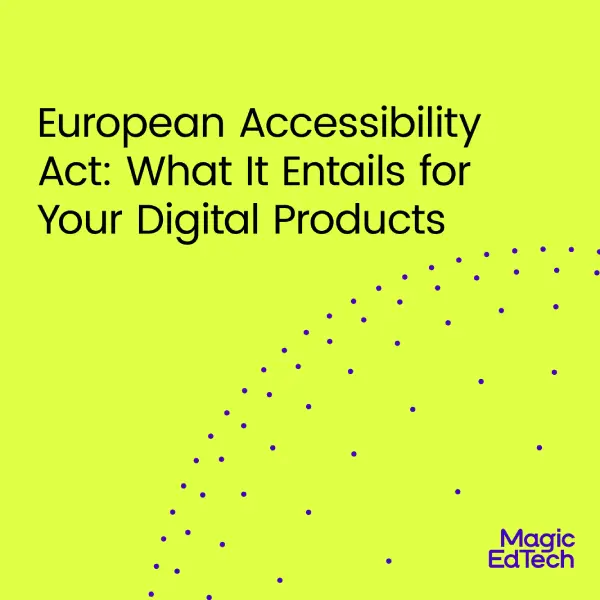How to Comply with the European Accessibility Act (EAA) | A Roadmap
- 8 May, 2023
- Reading Time: 4 mins
The European Accessibility Act (EAA) is a legislative initiative aimed at improving the accessibility of products and services across the European Union (EU). Its implementation in June 2022 marked a significant step towards ensuring that everyone, regardless of disability, can access and use products and services effectively.
However, despite existing laws and guidelines for accessibility in the EU, compliance with accessibility standards is still relatively low. The research has shown that almost none of the EU member states have websites or apps that meet the requirements after a full (in-depth) audit. With a simplified (automatic) scan 84% of the websites/apps do not pass the inspection. This highlights the need for initiatives like the EAA, which aim to improve accessibility across various products and services.
Although the EAA has been in effect since June 2022, businesses have been given until June 28, 2025, to comply with its requirements. Failing to comply with the EAA’s accessibility standards by the deadline, may result in legal consequences for non-compliant businesses.
How is EAA different from other Accessibility Standards?
The EAA differs from existing accessibility guidelines such as the Web Content Accessibility Guidelines (WCAG) and the Americans with Disabilities Act (ADA) in several ways. First, the EAA is a comprehensive accessibility law that covers a wide range of products and services.
Secondly, Unlike WCAG, the EAA has legal backing, meaning that private companies doing business in the EU must adhere to its standards. Failure to comply with EAA requirements may result in hefty fines or other legal consequences. So, make accessibility a top priority and avoid potential legal trouble with the EAA!
The EAA is enforced by national authorities in each EU Member State, while other accessibility may have different enforcement mechanisms in the form of voluntary compliance or private lawsuits.
Overall, the EAA is a crucial step taken by the EU to ensure accessibility for all. Its comprehensive scope and mandates make it an important aspect of legislation toward creating a more accessible EU.
Achieving compliance with the European Accessibility Act (EAA)
How your EAA compliance journey must begin:
If you are a business that is looking to comply with the European Accessibility Act (EAA), it can be overwhelming to know where to start. Here are a few steps to help you get started:
1. Familiarize yourself with the EAA: The first step is to understand the requirements of the EAA and how they apply to your business. You can start by reading the text of the EAA, as well as any official guidance and resources provided by the European Commission or national authorities.
2. Conduct an accessibility audit: To assess your current level of accessibility, you may want to conduct an accessibility audit of your products and services. This can help you identify any areas where accessibility improvements are needed.
3. Develop an accessibility policy: You should also develop an accessibility policy that outlines your commitment to accessibility and how you plan to comply with the EAA’s requirements. This policy should be communicated to all relevant stakeholders, including employees, customers, and suppliers.
Accessibility Tools and Measures to Choose for Your Business:
There is a wide range of accessibility measures and tools that businesses can use to comply with the EAA’s requirements. Here are a few key areas to consider:
1. User interface and design: Ensuring that your products and services have an accessible user interface and design is a crucial element of compliance with the EAA. This could include features such as alternative text for images, clear and simple language, and color contrast.
2. Compatibility with assistive technologies: Products and services should be compatible with assistive technologies such as screen readers, screen magnifiers, and alternative input devices.
3. Accessibility of documentation and support services: Your documentation and support services should be accessible to people with disabilities. This could include providing captions or transcripts for videos or providing support in accessible formats such as braille or easy-to-read language.
Final Steps in Achieving EAA Compliance:
Here are a few steps that businesses can take to move toward compliance with the EAA:
1. Develop an accessibility plan: Based on your accessibility audit and policy, you should develop a detailed plan for how you will achieve compliance with the EAA. This plan should include specific actions, timelines, and responsibilities.
2. Hire accessibility experts: Hiring an accessibility consultant or company can be a great way to develop a comprehensive plan and execute it effectively.
3. Engage with people with disabilities: Involve people with disabilities in your product development and testing processes, and seek their feedback on how to improve accessibility.
4. Test and monitor: Regularly test your products and services for accessibility, and monitor your progress toward compliance with the EAA.
Compliance with the EAA is essential for businesses to ensure their products and services are accessible to everyone. Hiring accessibility experts can be a valuable resource for your business as they can help identify gaps and make sure that your products and services meet the required standards. Additionally, it is important to stay updated on the latest regulations so you can comply with any new changes. By taking these steps, businesses can move towards compliance with the EAA and improve accessibility for people with disabilities.






